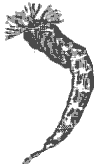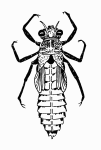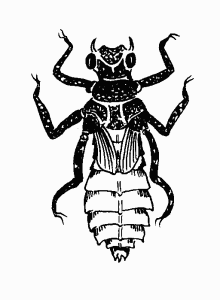Entomology
Chironomids
 Chironomids are commonly called midges, and
are the most abundant year round food source available to feeding trout.
They range in size from 2-25mm in length. They have long skinny segmented bodies
and are worm-like. As chironomid larva starts its transition into the pupal
stage they develop an eye-spot, wing casing and have noticeable white gills near
the head. The most common colors include yellow,
green, brown and red in the larval stage and black, brown and green in the pupa
and adult stages.
Chironomids are commonly called midges, and
are the most abundant year round food source available to feeding trout.
They range in size from 2-25mm in length. They have long skinny segmented bodies
and are worm-like. As chironomid larva starts its transition into the pupal
stage they develop an eye-spot, wing casing and have noticeable white gills near
the head. The most common colors include yellow,
green, brown and red in the larval stage and black, brown and green in the pupa
and adult stages.
 Chironomid larva are bottom dwellers and can
live in depths of 70 meters. They typically live in tubes in the mud or sand.
Although chironomid larva are available year round they are usually more active
as water temperatures rise. It is during the pupal ascent to the the surface
that chironomids are most heavily preyed upon. Chironomids fill an air sack
within their skin and wriggle to the surface, but are often suspended between
the lake bottom and surface. The pupa can be found at any depth but trout will
feed most heavily along the shoals and drop offs.
Chironomid larva are bottom dwellers and can
live in depths of 70 meters. They typically live in tubes in the mud or sand.
Although chironomid larva are available year round they are usually more active
as water temperatures rise. It is during the pupal ascent to the the surface
that chironomids are most heavily preyed upon. Chironomids fill an air sack
within their skin and wriggle to the surface, but are often suspended between
the lake bottom and surface. The pupa can be found at any depth but trout will
feed most heavily along the shoals and drop offs.
Dragonfly
Darner Nymph

 The
dragonflies are available year round but are most actively sought by trout in
the nymphs as they migrate to the shoreline vegetation in the spring as they
emerge as adults. When we talk of dragonfly nymphs we must distinguish between
the Darners and the Gomphus. The Darner nymph is long and slender in shape and
is usually found under logs, rocks or attached to submerged vegetation, It is an
active swimmer and found in a large variety of lake types.
The
dragonflies are available year round but are most actively sought by trout in
the nymphs as they migrate to the shoreline vegetation in the spring as they
emerge as adults. When we talk of dragonfly nymphs we must distinguish between
the Darners and the Gomphus. The Darner nymph is long and slender in shape and
is usually found under logs, rocks or attached to submerged vegetation, It is an
active swimmer and found in a large variety of lake types.
 The
Gomphus nymph is shorter and stubby in shape and has long spider-like legs. It's
entire body is often covered in hair-like projections which acts as a base for
algae to grow from. These nymphs are more sedentary in nature and are usually
found well hidden in submerged vegetation.
The
Gomphus nymph is shorter and stubby in shape and has long spider-like legs. It's
entire body is often covered in hair-like projections which acts as a base for
algae to grow from. These nymphs are more sedentary in nature and are usually
found well hidden in submerged vegetation.
Dragonfly nymphs have large bulbous eyes and have thick cigar
shaped bodies with pronounced legs. They range in size and can be as large as
40mm. The most common colors are olive green and shades of black, although dark
green, grays and reddish browns may be found. Dragonfly nymphs generally crawl
along the lake bottoms and weeds. They also have internal gills which they can
suck water into their bodies and expel with great force to provide rapid
movement through the water.
Gomphus Nymph
The Leech
 The
leech
The
leech
Fly
Patterns Entomology
Favorite
Spots Photo
Album The
Fly Box
 Chironomids are commonly called midges, and
are the most abundant year round food source available to feeding trout.
They range in size from 2-25mm in length. They have long skinny segmented bodies
and are worm-like. As chironomid larva starts its transition into the pupal
stage they develop an eye-spot, wing casing and have noticeable white gills near
the head. The most common colors include yellow,
green, brown and red in the larval stage and black, brown and green in the pupa
and adult stages.
Chironomids are commonly called midges, and
are the most abundant year round food source available to feeding trout.
They range in size from 2-25mm in length. They have long skinny segmented bodies
and are worm-like. As chironomid larva starts its transition into the pupal
stage they develop an eye-spot, wing casing and have noticeable white gills near
the head. The most common colors include yellow,
green, brown and red in the larval stage and black, brown and green in the pupa
and adult stages.
 Chironomid larva are bottom dwellers and can
live in depths of 70 meters. They typically live in tubes in the mud or sand.
Although chironomid larva are available year round they are usually more active
as water temperatures rise. It is during the pupal ascent to the the surface
that chironomids are most heavily preyed upon. Chironomids fill an air sack
within their skin and wriggle to the surface, but are often suspended between
the lake bottom and surface. The pupa can be found at any depth but trout will
feed most heavily along the shoals and drop offs.
Chironomid larva are bottom dwellers and can
live in depths of 70 meters. They typically live in tubes in the mud or sand.
Although chironomid larva are available year round they are usually more active
as water temperatures rise. It is during the pupal ascent to the the surface
that chironomids are most heavily preyed upon. Chironomids fill an air sack
within their skin and wriggle to the surface, but are often suspended between
the lake bottom and surface. The pupa can be found at any depth but trout will
feed most heavily along the shoals and drop offs.
 The
Gomphus nymph is shorter and stubby in shape and has long spider-like legs. It's
entire body is often covered in hair-like projections which acts as a base for
algae to grow from. These nymphs are more sedentary in nature and are usually
found well hidden in submerged vegetation.
The
Gomphus nymph is shorter and stubby in shape and has long spider-like legs. It's
entire body is often covered in hair-like projections which acts as a base for
algae to grow from. These nymphs are more sedentary in nature and are usually
found well hidden in submerged vegetation. The
leech
The
leech